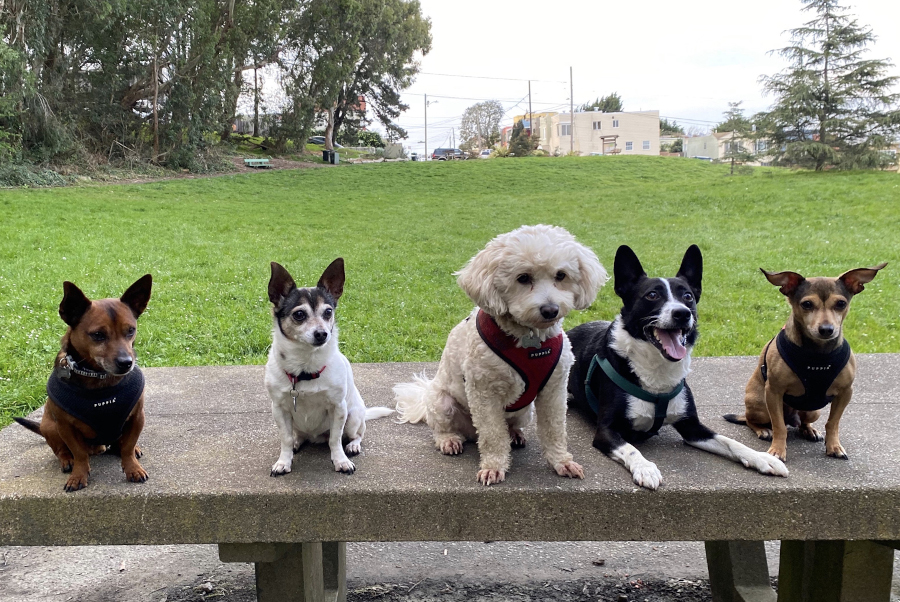Are Tiny Dogs Harder to Train?
Debunking the Myth of Small Dog Syndrome

You may have heard of "Small Dog Syndrome," or maybe you think that little dogs are inherently yappy, snippy, and nervous. But small dog syndrome isn't really a syndrome at all - it's a lack of training that leads to behaviors like barking, jumping, growling, or lap guarding. These annoying behaviors have nothing to do with breed or size.
Unfortunately, small dog guardians often have lower expectations and fewer boundaries than big dog owners. Small dogs frequently get away with behaviors we wouldn't allow from big dogs. A German Shepherd lunges and barks at strangers or other dogs and you call a trainer. The same behavior from a Maltipoo elicits laughs - and then the dog gets picked up. Tiny dogs are cute and squishy, so we tend to treat them like babies and not dogs.
My first two dogs were Rottweilers, and for a long time, I snobbishly believed that small dogs were not "real dogs." Then, 16 years ago, a tiny, delightful Chihuahua-Jack Russell puppy needed a home and turned me into a small dog person.
I quickly discovered that raising a little dog is no different than raising any other dog. Everyone wants a well-behaved dog, but training takes time, patience, and consistency, no matter how much your dog weighs. Approach training your small dog as if it’s a 90-pound dog. Use positive reinforcement training methods and don't force your dog into situations that make them uncomfortable.
Small dogs are not harder to train, but there are a few tips and tweaks that can make your training partnership easier.
Agency means the learner chooses what's happening to them and how they interact with their environment. Unfortunately, many little dogs rarely get the chance to consent. Instead, we scoop them up and physically move them rather than training them to sit or wait or stay or come. We don't think twice about picking up a small dog when they do something we don't want them to do. Learned helplessness is a result of lack of choices and inconsistent training.
Tiny dogs’ stress signals and warnings are frequently minimized or laughed off, creating unnecessary fear because their communications are often ignored. Distance-increasing behaviors like growling and barking should be respected and acknowledged rather than dismissed.
- Small dogs have tiny bellies, so prioritize training during meal times.
- Ditch the food bowl and use its regular kibble for training.
- Treats should be pea-sized (or smaller) to avoid satiation and weight gain.
- A kitchen spoon with a spreadable treat (like peanut butter or cream cheese) makes rewarding easy without a lot of bending over.
- You can and should also use toys and play as a reward.
Bending down to deliver treats is the hardest part of training small dogs. Looming over them can also be intimidating.
- Sit on the ground to teach new skills and then incrementally get your dog used to responding to the cues from an upright posture.
- Once your dog knows a cue, you will be able to stand normally - they can hear and see you just fine.
- Consider using a platform or low table for training.
- When teaching "down", use a mat or carpet rather than a slippery surface.
Management means changing your dog's environment so that they cannot engage in certain behaviors. Management is not training, but you must manage your dog's environment so that it cannot rehearse behaviors you are trying to eliminate. For example:
- Keep your dog on a leash when greeting people until they learn not to jump up.
- Use a harness on walks, as tension on a regular collar can cause tracheal damage.
- Avoid retractable leashes, as you have very little control over your dog, and they make it harder to teach loose leash walking. (Read Retractable Leashes: Dangerous And Deadly For Dogs And Humans).
- Use a harness and leash or baby gates to prevent your dog from lunging or jumping on people when they come into your home.
Understand that you will continue training, on some level, throughout your dog's entire life. For a well-behaved dog, make training a daily habit. Incorporate a few seconds of training whenever you go on a walk, take your dog out for a potty break, put your dog's leash/harness on or off, or when new people come into the house.
Training should be fun for both you and your dog. Don't think of training as a chore or something to finish as quickly as possible. If you get frustrated or bored or your dog gets tired or starts making mistakes, take a break and try again later. A few short training sessions (2-5 minutes) spaced throughout the day are better than a single large chunk of time.
Training using positive reinforcement creates a powerful bond between you and your dog. So don’t fall for the small dog propaganda. Train your tiny pal like the real dog it is and get ready to reap a lifetime of benefits for both of you.

